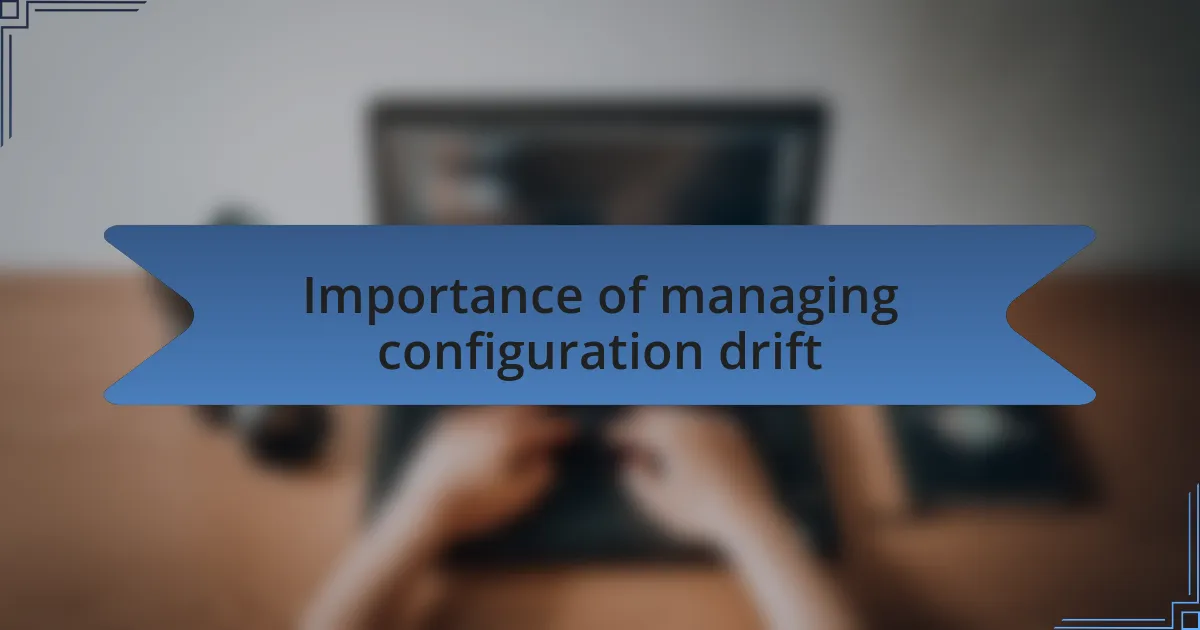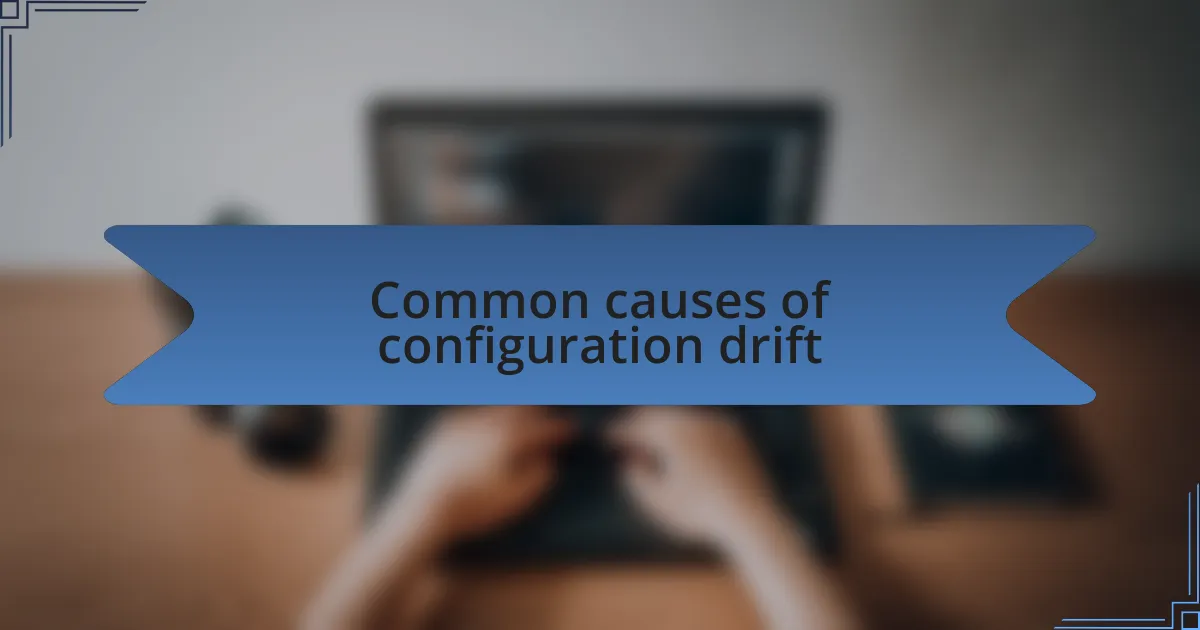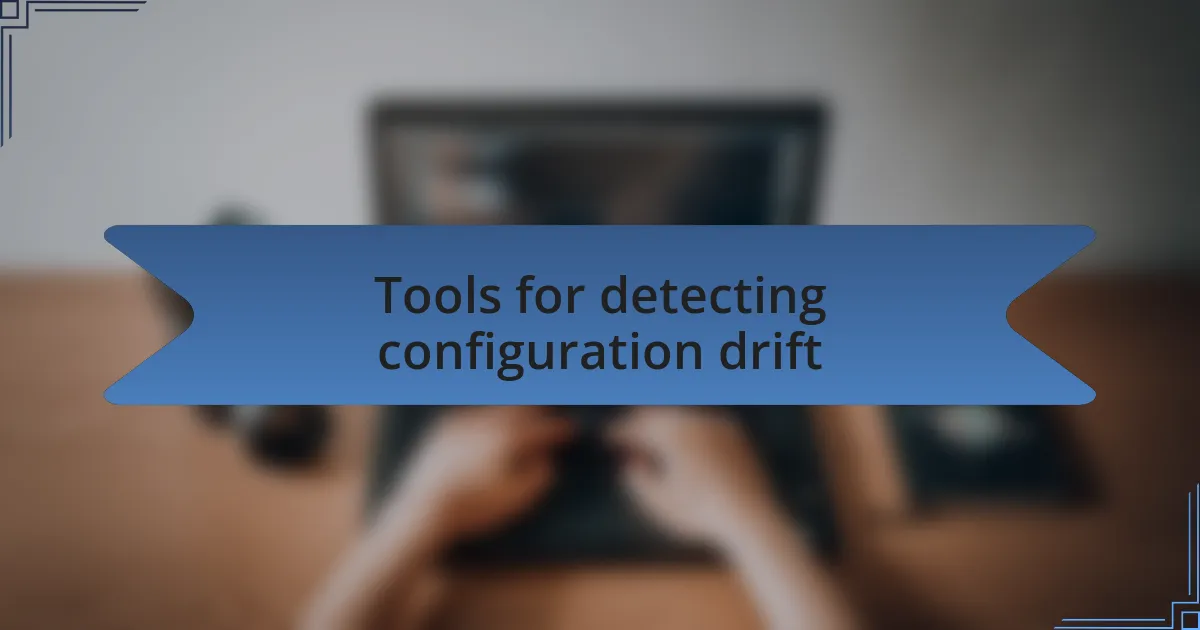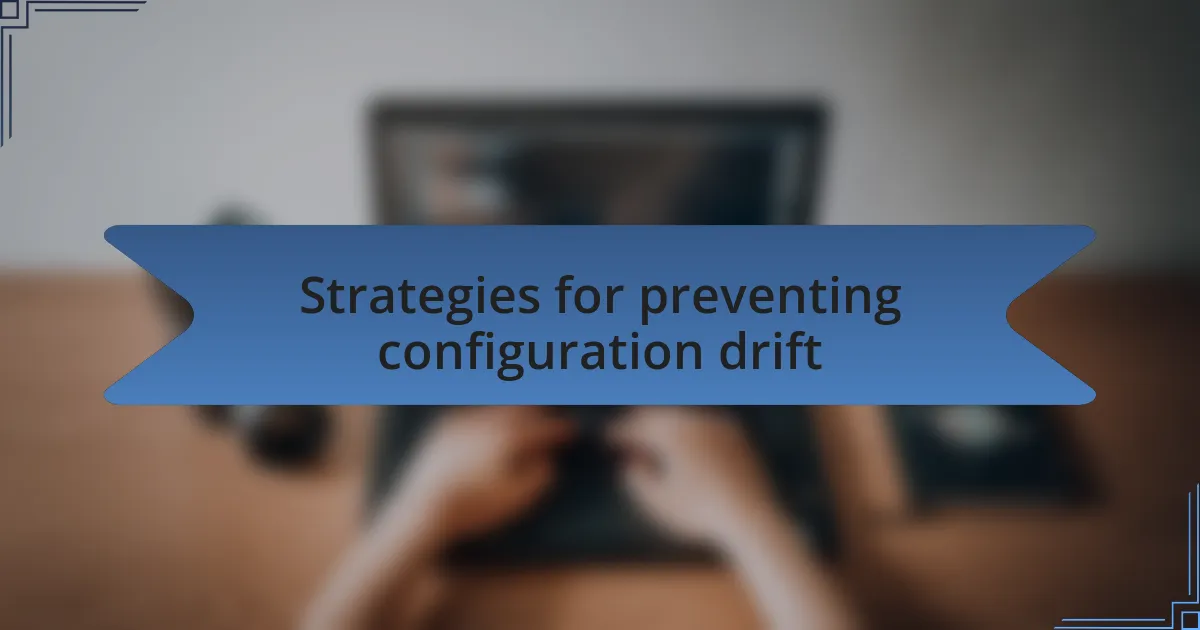Key takeaways:
- Configuration drift can destabilize software deployments, leading to reliability issues and diminished user trust.
- Common causes include human error, inconsistency among team members, and external factors like third-party updates.
- Tools like Terraform, Ansible, and Puppet are crucial for detecting and managing configuration drift effectively.
- Establishing version control, a configuration management policy, and conducting regular audits are essential strategies for preventing drift.

Understanding configuration drift
Configuration drift occurs when the deployed environment of a system diverges from its intended configuration. I once faced this issue when a critical server started behaving unpredictably due to unnoticed manual changes. It made me realize just how crucial it is to maintain an accurate and consistent environment.
Imagine spending hours debugging an issue, only to discover that a simple configuration change made weeks ago was the root cause. It can be frustrating and, honestly, a bit overwhelming. This experience taught me the importance of robust configuration management practices.
When I talk about configuration drift, I often think of it like weeds in a garden. If left unchecked, they can quickly take over and choke the healthy plants. How do we ensure that we keep our configurations tidy and in check? For me, regular audits and automated monitoring became essential tools in preventing drift and keeping my environments aligned with their desired states.

Importance of managing configuration drift
Managing configuration drift is vital because it ensures the stability and reliability of software deployments. I remember a time when I had to roll back a release because a change in configuration led to unexpected downtime. It was a steep lesson: even minor discrepancies can snowball into significant issues if left unaddressed.
Regularly addressing configuration drift is not just a technical necessity; it’s also about preserving the trust of your users. I’ve had clients question our commitment to quality because of transient issues that arose from unnoticed changes. It made me realize that maintaining a pristine environment isn’t just about functionality; it’s also about building and retaining positive relationships with stakeholders.
The consequences of ignoring configuration drift can be detrimental, leading to security vulnerabilities and compliance issues. Have you ever experienced a system failure that halted progress? I have, and it’s in those moments of crisis that I’ve learned the importance of proactive configuration management. By staying ahead of potential drifts through diligent oversight, I’ve managed to protect integrity and foster a more secure development culture.

Common causes of configuration drift
Configuration drift often arises from human error during manual updates. I recall a time when a colleague inadvertently introduced a new library version that wasn’t approved, which led to unexpected behavior in production. It’s a stark reminder that even well-intentioned changes can create discrepancies that materialize into issues down the line.
Another common culprit is the inconsistency among team members. When different developers employ varying tools or methods, it can result in divergent configurations that deviate from the established baseline. I’ve seen teams struggle with incompatible dependencies simply because we didn’t consistently document our processes. It’s vital, I’ve learned, to cultivate a culture where everyone is on the same page.
External factors, such as updates to third-party services, can also lead to drift. Once, our application faced a significant performance drop after a cloud provider altered its infrastructure without notice. This experience taught me that understanding the ecosystem in which our software operates is crucial to maintaining stability. How do you ensure your team is prepared for such changes? I’ve found that proactive monitoring and open communication can significantly mitigate these unexpected challenges.

Tools for detecting configuration drift
When it comes to detecting configuration drift, one tool that I find invaluable is Terraform. Using its state file, I can easily track changes to my infrastructure and spot any discrepancies compared to my desired configuration. I remember a project where I implemented Terraform and caught an unauthorized change ahead of deployment, which saved us from potential downtime.
Additionally, Ansible stands out as another effective tool for this purpose. Its ability to regularly apply configurations ensures that any drift is not only detected but also rectified automatically. I still recall a particularly stressful incident where a server’s configuration changed unexpectedly; Ansible helped me restore the previous settings with minimal hassle, reminding me of its importance in a smooth workflow.
Another powerful option is Puppet. I appreciate how its reporting features provide insight into the current state of configurations across systems. There was this time when I had to manage multiple servers, and Puppet’s visual representation of discrepancies allowed me to focus on critical issues quickly. It made me realize that having the right tools at your disposal can greatly enhance your peace of mind. How do you handle your configuration drift detection? From my experience, leveraging these tools not only saves time but also allows for a more proactive approach to system management.

Strategies for preventing configuration drift
One effective strategy I’ve adopted is to implement a strict version control system for all configuration files. This practice has been a game-changer for me, as every change is documented and can be rolled back if necessary. I can’t tell you how many times a version-controlled environment saved me from waking up in a panic after a failed deployment; knowing I could revert to a stable state provided incredible peace of mind.
In addition to version control, I highly recommend establishing a configuration management policy that outlines how configurations should be applied and modified. When I worked on a large team, having clear guidelines allowed us to collaborate more seamlessly and minimized unintended changes. It’s amazing how a little structure can create such a big impact—wouldn’t it be reassuring to have everyone on the same page when it comes to configurations?
Another tactic I value is the regular auditing of configurations to ensure compliance with the predefined standards. I remember an instance where I ran monthly audits and discovered a series of drifted settings that could have led to significant issues. This routine not only keeps configurations in check but also instills a sense of accountability among team members. How do you ensure that everyone is adhering to the established guidelines? From my experience, consistent audits foster a culture of diligence and awareness around configuration management.

Lessons learned from my journey
Throughout my journey in handling configuration drift, one of the most important lessons I learned is the value of open communication within the team. In one project, we faced a major setback because a critical change was made without notifying everyone. That experience taught me that fostering a culture where team members feel comfortable sharing updates can significantly reduce the risk of drift. Have you ever been caught off guard by unexpected changes in your projects? I certainly have, and it reinforced my belief that dialogue can be just as vital as any technical strategy.
Another key takeaway is the significance of documentation. I once neglected to document a complex series of configuration adjustments I made, thinking I could remember them all. A few weeks later, when we encountered issues during a deployment, I realized my oversight had created confusion and delays. This experience underscored the necessity of maintaining clear, concise documentation at every step. It’s fascinating how something as simple as a well-maintained record can save you countless headaches down the line.
Finally, I’ve come to see the unpredictability of technology as an opportunity for continuous learning. Each time I encountered a drift issue, it led me to explore new tools and techniques that enhanced my workflow. I remember diving into automation tools after one particularly frustrating episode with manual configurations. Embracing change has often transformed challenges into stepping stones for improvement. How do you approach setbacks in your own work? For me, turning those moments into learning experiences has been invaluable.